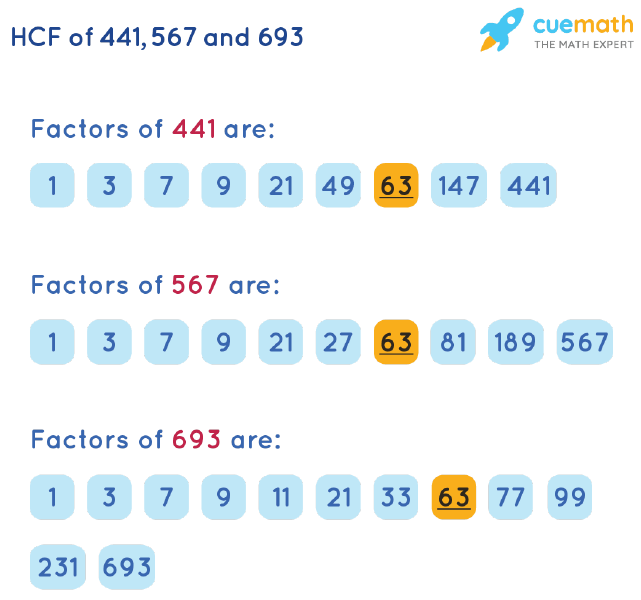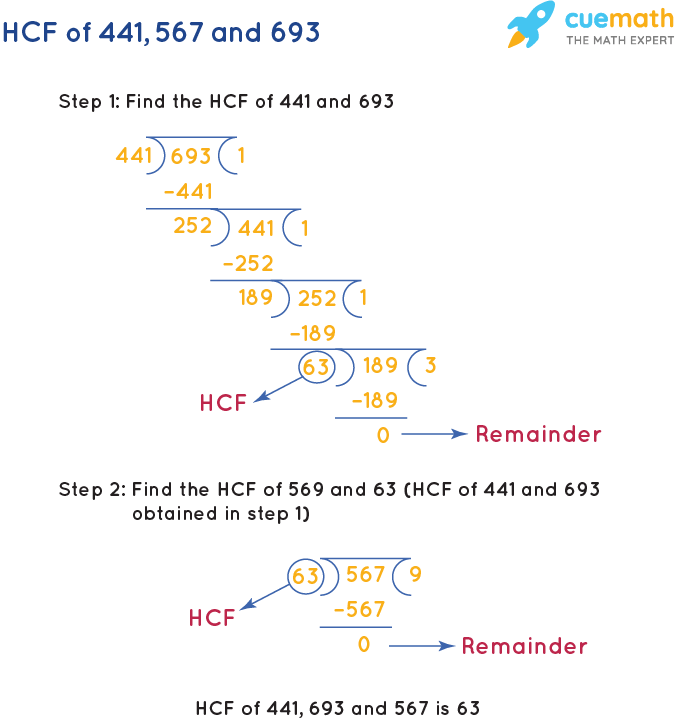HCF of 441, 567 and 693
HCF of 441, 567 and 693 is the largest possible number that divides 441, 567 and 693 exactly without any remainder. The factors of 441, 567 and 693 are (1, 3, 7, 9, 21, 49, 63, 147, 441), (1, 3, 7, 9, 21, 27, 63, 81, 189, 567) and (1, 3, 7, 9, 11, 21, 33, 63, 77, 99, 231, 693) respectively. There are 3 commonly used methods to find the HCF of 441, 567 and 693 - long division, Euclidean algorithm, and prime factorization.
| 1. | HCF of 441, 567 and 693 |
| 2. | List of Methods |
| 3. | Solved Examples |
| 4. | FAQs |
What is HCF of 441, 567 and 693?
Answer: HCF of 441, 567 and 693 is 63.

Explanation:
The HCF of three non-zero integers, x(441), y(567) and z(693), is the highest positive integer m(63) that divides x(441), y(567) and z(693) without any remainder.
Methods to Find HCF of 441, 567 and 693
Let's look at the different methods for finding the HCF of 441, 567 and 693.
- Listing Common Factors
- Long Division Method
- Using Euclid's Algorithm
HCF of 441, 567 and 693 by Listing Common Factors

- Factors of 441: 1, 3, 7, 9, 21, 49, 63, 147, 441
- Factors of 567: 1, 3, 7, 9, 21, 27, 63, 81, 189, 567
- Factors of 693: 1, 3, 7, 9, 11, 21, 33, 63, 77, 99, 231, 693
There are 6 common factors of 441, 567 and 693, that are 1, 3, 7, 9, 21, and 63. Therefore, the highest common factor of 441, 567 and 693 is 63.
HCF of 441, 567 and 693 by Long Division

HCF of 441, 567 and 693 can be represented as HCF of (HCF of 441, 567) and 693. HCF(441, 567, 693) can be thus calculated by first finding HCF(441, 567) using long division and thereafter using this result with 693 to perform long division again.
- Step 1: Divide 567 (larger number) by 441 (smaller number).
- Step 2: Since the remainder ≠ 0, we will divide the divisor of step 1 (441) by the remainder (126). Repeat this process until the remainder = 0.
⇒ HCF(441, 567) = 63. - Step 3: Now to find the HCF of 63 and 693, we will perform a long division on 693 and 63.
- Step 4: For remainder = 0, divisor = 63 ⇒ HCF(63, 693) = 63
Thus, HCF(441, 567, 693) = HCF(HCF(441, 567), 693) = 63.
HCF of 441, 567 and 693 by Euclidean Algorithm
As per the Euclidean Algorithm, HCF(X, Y) = HCF(Y, X mod Y)
where X > Y and mod is the modulo operator.
HCF(441, 567, 693) = HCF(HCF(441, 567), 693)
- HCF(567, 441) = HCF(441, 567 mod 441) = HCF(441, 126)
- HCF(441, 126) = HCF(126, 441 mod 126) = HCF(126, 63)
- HCF(126, 63) = HCF(63, 126 mod 63) = HCF(63, 0)
- HCF(63, 0) = 63 (∵ HCF(X, 0) = |X|, where X ≠ 0)
Steps for HCF(63, 693)
- HCF(693, 63) = HCF(63, 693 mod 63) = HCF(63, 0)
- HCF(63, 0) = 63 (∵ HCF(X, 0) = |X|, where X ≠ 0)
Therefore, the value of HCF of 441, 567 and 693 is 63.
☛ Also Check:
- HCF of 144 and 192 = 48
- HCF of 12 and 20 = 4
- HCF of 87 and 145 = 29
- HCF of 3 and 9 = 3
- HCF of 2 and 8 = 2
- HCF of 34 and 85 = 17
- HCF of 120 and 144 = 24
HCF of 441, 567 and 693 Examples
-
Example 1: Verify the relation between the LCM and HCF of 441, 567 and 693.
Solution:
The relation between the LCM and HCF of 441, 567 and 693 is given as, HCF(441, 567, 693) = [(441 × 567 × 693) × LCM(441, 567, 693)]/[LCM(441, 567) × LCM (567, 693) × LCM(441, 693)]
⇒ Prime factorization of 441, 567 and 693:- 441 = 3 × 3 × 7 × 7
- 567 = 3 × 3 × 3 × 3 × 7
- 693 = 3 × 3 × 7 × 11
∴ LCM of (441, 567), (567, 693), (441, 693), and (441, 567, 693) is 3969, 6237, 4851, and 43659 respectively.
Now, LHS = HCF(441, 567, 693) = 63.
And, RHS = [(441 × 567 × 693) × LCM(441, 567, 693)]/[LCM(441, 567) × LCM (567, 693) × LCM(441, 693)] = [(173282571) × 43659]/[3969 × 6237 × 4851]
LHS = RHS = 63.
Hence verified. -
Example 2: Find the highest number that divides 441, 567, and 693 completely.
Solution:
The highest number that divides 441, 567, and 693 exactly is their highest common factor.
- Factors of 441 = 1, 3, 7, 9, 21, 49, 63, 147, 441
- Factors of 567 = 1, 3, 7, 9, 21, 27, 63, 81, 189, 567
- Factors of 693 = 1, 3, 7, 9, 11, 21, 33, 63, 77, 99, 231, 693
The HCF of 441, 567, and 693 is 63.
∴ The highest number that divides 441, 567, and 693 is 63. -
Example 3: Calculate the HCF of 441, 567, and 693 using LCM of the given numbers.
Solution:
Prime factorization of 441, 567 and 693 is given as,
- 441 = 3 × 3 × 7 × 7
- 567 = 3 × 3 × 3 × 3 × 7
- 693 = 3 × 3 × 7 × 11
LCM(441, 567) = 3969, LCM(567, 693) = 6237, LCM(693, 441) = 4851, LCM(441, 567, 693) = 43659
⇒ HCF(441, 567, 693) = [(441 × 567 × 693) × LCM(441, 567, 693)]/[LCM(441, 567) × LCM (567, 693) × LCM(693, 441)]
⇒ HCF(441, 567, 693) = (173282571 × 43659)/(3969 × 6237 × 4851)
⇒ HCF(441, 567, 693) = 63.
Therefore, the HCF of 441, 567 and 693 is 63.

FAQs on HCF of 441, 567 and 693
What is the HCF of 441, 567 and 693?
The HCF of 441, 567 and 693 is 63. To calculate the highest common factor (HCF) of 441, 567 and 693, we need to factor each number (factors of 441 = 1, 3, 7, 9, 21, 49, 63, 147, 441; factors of 567 = 1, 3, 7, 9, 21, 27, 63, 81, 189, 567; factors of 693 = 1, 3, 7, 9, 11, 21, 33, 63, 77, 99, 231, 693) and choose the highest factor that exactly divides 441, 567 and 693, i.e., 63.
What is the Relation Between LCM and HCF of 441, 567 and 693?
The following equation can be used to express the relation between LCM (Least Common Multiple) and HCF of 441, 567 and 693, i.e. HCF(441, 567, 693) = [(441 × 567 × 693) × LCM(441, 567, 693)]/[LCM(441, 567) × LCM (567, 693) × LCM(441, 693)].
☛ HCF Calculator
Which of the following is HCF of 441, 567 and 693? 63, 695, 702, 742, 732, 734, 728, 725, 723
HCF of 441, 567, 693 will be the number that divides 441, 567, and 693 without leaving any remainder. The only number that satisfies the given condition is 63.
How to Find the HCF of 441, 567 and 693 by Prime Factorization?
To find the HCF of 441, 567 and 693, we will find the prime factorization of given numbers, i.e. 441 = 3 × 3 × 7 × 7; 567 = 3 × 3 × 3 × 3 × 7; 693 = 3 × 3 × 7 × 11.
⇒ Since 3, 3, 7 are common terms in the prime factorization of 441, 567 and 693. Hence, HCF(441, 567, 693) = 3 × 3 × 7 = 63
☛ Prime Number
What are the Methods to Find HCF of 441, 567 and 693?
There are three commonly used methods to find the HCF of 441, 567 and 693.
- By Prime Factorization
- By Euclidean Algorithm
- By Long Division
visual curriculum